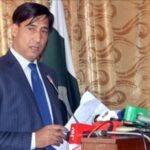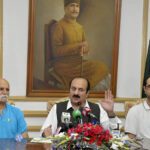ISLAMABAD, Apr 8 (APP):Prime Minister Imran Khan on Monday said the Pakistan Tehreek-e-Insaf’s Ehsaas programme was a step towards creation of a welfare state, aimed at reducing inequality, alleviating poverty, investment in people and uplift of districts lagging behind in development.
In a 15-page policy statement released here by the PM Office, he said Ehsaas launched on March 27, would use data and technology to create precision safety nets, promote financial inclusion and access to digital services, and support economic empowerment of women.
He said the programme would focus on four areas through 115 policy actions. It relied on addressing the chronic issue of elite capture – a form of corruption whereby public resources were biased for the benefit of a few individuals of superior social status.
The other three priority areas, he said, aimed at making the government system create equality, safety nets for disadvantaged segments of the population, jobs and livelihoods, and human capital development.
“Ehsaas is the biggest and the boldest programme for the poor, ever launched in Pakistan,” the prime minister said in his statement.
“The government looks forward to working with all stakeholders—public, private, civil society, philanthropists, and expatriate Pakistanis—to ensure that we deliver on our promise of lifting millions of people out of poverty and build a strong foundation together for a stronger, safer, and successful Pakistan.”
The programme developed by the Poverty Alleviation Coordination Council after extensive consultations would also focus on central role of human capital formation for poverty eradication, economic growth and sustainable development, besides overcoming financial barriers to accessing health and post-secondary education.
The prime minister, in a tweet, said he was pleased to release his policy statement on Ehsaas – “my priority poverty reduction programme with its 4 focus areas and 115 policy actions to reduce inequality, invest in people, and uplift lagging districts.”
He said the programme’s premise was grounded in the importance of strengthening institutions, transparency and good governance. It was designed for the extreme poor, orphans, widows, homeless, disabled and those, who risked medical impoverishment.
Imran Khan said it would also cater to the jobless, poor farmers, labourers, the sick and undernourished, students from low-income backgrounds, poor women and elderly citizens.
He pointed out that it would center on tapping whole-of-government multi-sectoral collaboration for solution, ensuring joint federal-provincial leadership, and mainstreaming the role of private sector.
The programme would also create jobs and promote means for livelihood, he added.
The prime minister said it was the government’s prime duty to cater for those who were left behind, and to build safeguards against the elite capture, which was evident in the taxation system, water management, crop choices, land use priorities, labour laws and much else.
He said Ehsas set a policy direction for initiatives to providing relief to the economically venerable segments such as the Benazir Income Support Programme. It proposed to amend the Constitution to legally bind the government to provide food, shelter and basic social services to all the citizens.
He said additional Rs 80 billion would be added to the social protection spending in the forthcoming budget (2019-20) and in the next budget (2020-21) there would be a further increase; hence total incremental increase would be Rs120 billion. At that level, the social protection spending would be 1 % of the GDP (gross domestic product) with federal and provincial contribution.
The Social Welfare Ministry, the prime minister said, created for the implementation of the social protection policy would serve to supervise all pro-poor projects. The entity would create a dependable database of needy households. It would also develop a network of centres to serve the poor by helping them with legal aid, skill development, job placement and access to banks for micro-loans.
The prime minister said special schemes for women to allow them to better care for themselves and their families had been formed in the Ehsas programme.
The programme Kifalat, he said, would ensure financial and digital inclusion of around 6 million women through the one woman one bank account policy. Some 500 digital hubs would be established at the Tehsil level under Kifalat where the government’s digital resources would be made accessible to create opportunities for poor families to graduate out of poverty, he added
He said the shock-oriented precision safety net, Tahafaz, would protect the vulnerable against shocks. It would involve one-time financial assistance to protect against catastrophic events, assistance to poor widows who did not have any earning children and legal aid, besides partnership with NGOs (non-governmental organizations) to upscale successful programmes for orphans, street children, seasonal migrants, transgender, victims of child and bonded labour, and daily wage workers, he added.
Under the Ehsas programme, Ehsaas homes for 10,000 orphans and Panah Gahs (shelter homes) in several major cities would be constructed while housing scheme for the poor (including landless farmers) through interest free loans would be launched.
To give protection against catastrophic health expenditures, Insaf Insurance card in 38 districts for 3.3 million people would be issued while ensuring financial access to treatment in defined categories and protecting the poor against catastrophic health expenditures through Tahafaz would be ensured, the statement added.
Besides human capital development, the prime minister said the Ehsas programme aimed at addressing stunting in children, provision of de-worming drugs, iron, folic acid, micro nutrient supplements through government hospitals, awareness regarding breast feeding and complimentary feeding, 5+1 model of desi chicken asset transfer for poverty alleviation and nutrition, a kitchen gardening initiative to promote subsidized certified seed and specialized nutrition food made available for stunted and wasted children in a cost effective manner, and initiative to address spurious and adulterated milk.
He said pro-poor education initiatives included awareness drive aimed at article 25-A so that the disadvantaged become aware of their right and access to education for poor through vouchers where public schools do not exist, but private schools exist, need-based undergraduate scholarships by the Higher Education Commission for students from low-income families and lagging districts to ensure that all qualified students have access to undergraduate education regardless of income, gender, or location.
This policy, he said, would be applicable to public sector and participating non-profit private sector colleges and universities.
Under the Ehsas programme, the prime minister policy statement said, in health sector, a universal health coverage policy would be adopted at federal and provincial levels with innovative technology tools to increase geographic and financial access to healthcare for communicable and non-communicable diseases and for maternal and child health, and mental health services.
Employment generation, the statement said, was a major objective of the broader economic reform agenda.
Notwithstanding, a certain set of employment opportunities were included in the Ehsaas framework to promote jobs and livelihoods, despite current limitations, he added.
The government’s Interest Free Loaning policy and graduation tools (asset transfer and skills development), he said, would be developed around the Solutions Innovation Challenge and Prize Funding.
The prime minister the Ehsas programme also aimed at introduction of skills training in school curricula and two-year college programmes, rationalizing requirements of 8th class as conditionality for enrollment in TVETAs, decrease in the age of enrollment from 18 to 15 in TVET institutions so that after matriculation, skills training could be started.
Change in NAVTCC’s law would introduce the mandate to check the mushrooming of substandard and unregulated Trade Testing Centers being run by manpower exporters, which was one of the causes in compromising quality and subsequent exploitation of labour, he added.
A consolidated labou market information system for overseas employment, the prime minister said, would be introduced so that intended migrant workers could be empowered, and were not exploited by middlemen.
Manpower export, he said, was priority of the government, where opportunities in neighbouring countries, and other emerging opportunities in countries like Japan and Germany that have ageing populations and need human resources, would be sought.
The success of the wide-ranging plan with transformational potential, he said, would hinge on two factors – the effectiveness of population control measures on the one hand, and the quality and speed of implementation, on the other. The latter was deeply interlinked with governance effectiveness, the PM policy statement said.







